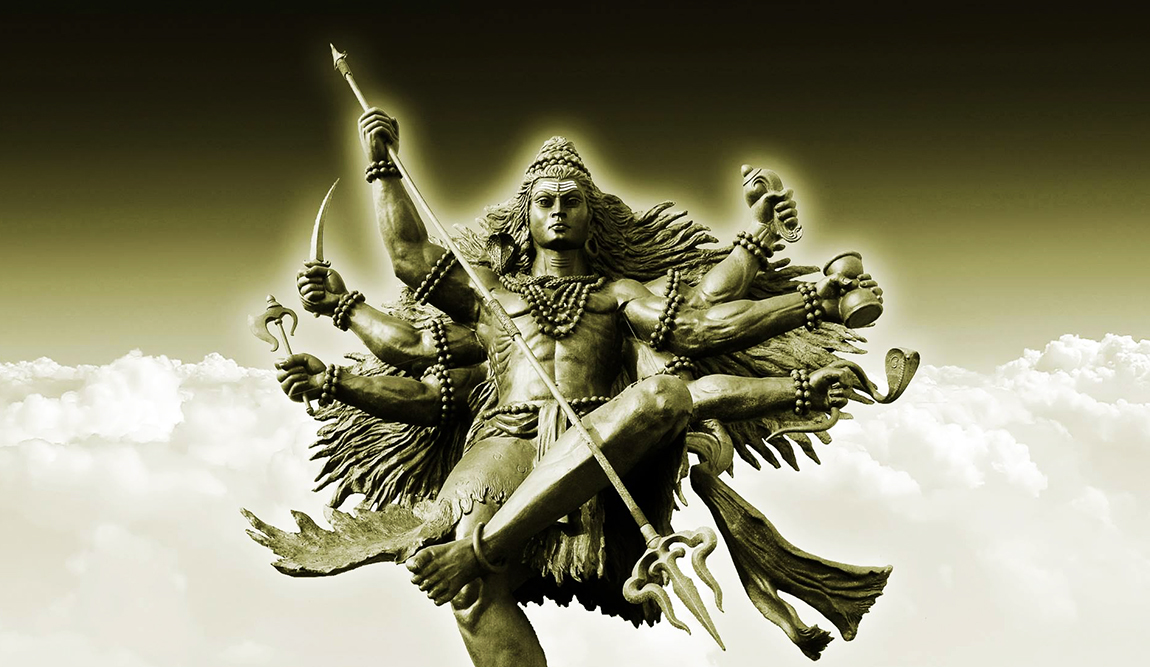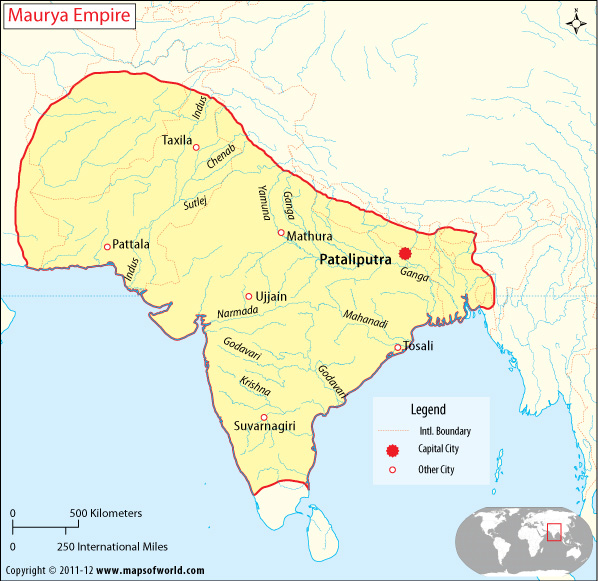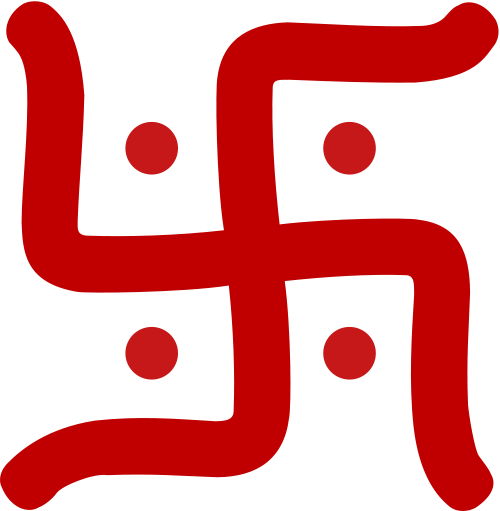TOTALITARIANISM IN ANCIENT INDIA

The term "totalitarianism" was invented by Mussolini in the 20th century. Yet the roots of this ideology go back to ancient times.
Authoritarian rule via a rigid caste system has been the norm in Indian History since the writing of the Vedas (1500-1000 BCE). Contrary to what many people in the West believe, Pacifism was not a key part of India's history. The ideas of harsh totalitarian rule from the Arthashastra played a key role in bringing several kingdoms together in the South Asian sub-continent into what became the Mauryan Empire (322-185 BCE).
This article will discuss more of the Totalitarian roots of ancient Indian history, along with the role that a rigid, racial based caste system played in the hierarchy of Hindu society, and how these ideas became influential on fascism in the 20th century.
NOTE: A BRIEF STATEMENT OF PUBLICATIONS PRINCIPLES
The World Future Fund serves as a source of documentary material, reading lists, and internet links from different points of view that we believe have historical significance. The publication of this material is in no way whatsoever an endorsement of these viewpoints by the World Future Fund, unless explicitly stated by us. As our web site makes very clear, we are totally opposed to ideas such as racism, religious intolerance, and communism. However, in order to combat such evils, it is necessary to understand them by means of the study of key documentary material. For a more detailed statement of our publications standards click here.
THE ARRIVAL OF ARYANS IN INDIA
AND THE BEGINNING OF THE CASTE SYSTEM
The word "Aryan" itself is a controversial term. In the 20th century the Nazi's appropriated the term to refer to their idea of the Master Race. However, in a historical sense, "Aryan" refers to the wave of people who immigrated to India from Indo-Europe. In sanskrit the word means "noble."
During the Iron Age, waves of Indo-Aryans migrated to the Indian subcontinent from the north-west. These Aryans didn't arrive all at once, rather they arrived over a long period of time starting roughly around 1500 BCE. The populations that the Indo-Aryans encountered, the Dasas, were darker in color and thus were marked as shudras. The Aryans changed their caste structure to be marked along new racial lines, for fear of intermixing with the darker skinned Dasas. The Sudras were placed at the bottom of the caste system.
Over time, the caste system was cemented into the following hierarchy: brahmins, kshatriyas, vaishyas and shudras in that order.
Harsh rules were formed for each caste to obey, and the lower a person was on this social hierarchy, the greater their punishment would be for violating the law. The rules for each caste are described in the key spiritual texts of India: the Rig Veda, the Bhagavadgita, the Khangoya Upanishad and the Manusmriti.
World Future Fund also has a report listing the Quotations on the Caste System from the Ancient Religious Texts of India.
Racial mixing outside of one's own caste was strictly forbidden in most situations. These laws were so harsh, that if a person from a lower caste even touched a person from a higher caste, they could be put to death.
"If one who (being a member of the Kandala or some other low caste) must not be touched, intentionally defiles by his touch one who (as a member of a twice-born caste) may be touched (by other twice-born persons only), he shall be put to death. (Vishnusmriti, Chapter 5 Line 104)."
KAUTILYA'S ARTHASHASTRA
TOTALITARIAN POLITICAL REVOLUTION FORMS FIRST INDIAN EMPIRE
The Arthashastra is an ancient Indian treatise on political rule and statecraft. The author is identified by the names "Kautilya" and "Vishnugupta." Both names are associated with Chanakya (350-283 BCE), who was the tutor and Royal Minister of Emperor Chandragupta Maurya, the founder of the Mauryan Empire (322-185 BCE). Chandragupta was the first emperor to unify an assortment of small kingdoms in the South Asian sub-continent into a singular empire. However, the southern tip of the sub-continent remained unconquered.
What is important to know about the Arthashastra however is that it contained a philosophy for transforming a nation into a police state. The book contains calculating and even brutal measures for accomplishing "the good of the state," even if these measures required assassination, torture, espionage, harsh criminal punishments or war.
The good of state triumphed over all. Kautilya even claims that a leader must sometimes do evil actions in order to ensure the greater good of the state.
According to Kautilya, the king of a state has been created to be the protector of the castes and social order.
INTERNATIONAL POLICY - ALWAYS ASSUME YOUR GEOGRAPHIC NEIGHBOR IS AN ENEMY
Kautilya was one of the first theorists to consider a nation's neighbors to automatically be enemies. In the Arthashastra, Kautilya assumes that all nations are acting in their own self interest. He even describes diplomacy as a subtle act of war, a mechanism through which a king can gradually weaken neighbor states to lower their status as a threat. He even considered all ambassadors as potential spies.
The Mahabharata, an ancient Hindu text, echoes this wisdom, "Carry your enemy on your shoulders as long as it is necessary, when the right moment arrives, dash him down to pieces." (Indra 1957, 80)
THE KING OF A STATE MUST CONSTANTLY ATTEND TO MATTERS OF WARFARE
EXPANSION OF THE STATE IS THE ULTIMATE GOOD
Much like Machiavelli's The Prince advised a king to attend to matters of warfare constantly, so too did Kautilya advise a king to not leave military matters entirely in another's hands. He believed that expansion of a prosperous kingdom was inevitable, natural and good - anything other than what was good for the kingdom was not considered.
In outlining military campaigns, Kautilya bluntly disregards humanitarian principles laid down to regulate the conduct of war. He lists "piety, piousness and regard for the other world" as hindrances to greater gains. In fact, the Arthashastra is a book that is quite candid about the use of torture on the enemy.
THE ESTABLISHMENT OF A POLICE STATE MONITORED BY SPIES
Kautilya trusted no one. He believed that a king should test the trust the closest members of the family and staff with bribes and trials. Such a trial could include offering up a bribe, an offer of power or the enticement of sexual pleasure.
Kautilya also stated that a king should establish a vast network of spies outside the palace: spies in every neighborhood and every village. The use of the spy went beyond collecting public opinion. The purpose was to establish an omnipresent authority and a state of omniscience for the king. The purpose was to create an atmosphere of distrust and fear. In such a society, a subject would even fear confiding in their best friend or spouse out of fear of being reported. The purpose was to create a state of psychological isolation that went beyond mere loneliness. In such a state of fear and distrust, a ruler could monitor the behavior of his subjects and enforce the ultimate authority of the state.
CHANDRAGUPTA'S MAURYAN EMPIRE

The Arthashastra and the teachings of Kautilya were obviously a major catalyst in the formation of Chandragupta's empire, which was the first unified empire in the region. Prior to Chandragupta's ascension to power, the South Asian Sub-continent was a collection of smaller states. Yet by the end of his reign, Chandragupta had succeeded in conquering all the territory shown in the map above.
Once Chandragupta conquered his empire, he introduced a drastic reorganization of the newly unified state according to the principles of the Arthashastra. The Mauryan Empire ran on a highly efficient and well organized bureaucracy with a large civil service sector. Chandragupta imposed a series of major economic and political reforms that helped unify the kingdom.
Chandragupa even succeeded in conquering the easternmost states of Alexander the Great's empire, along with defeating Alexander's successor Seleucus in battle.
Without the harsh ideologies of The Arthashastra,
it is possible that there would not have been a Mauryan Empire. We must
remember that along with Chandragupta's prosperous economic policies,
the Mauryan Empire was still an authoritarian regime where nearby states
were conquered and the population was kept in line via harsh measures
for the greater good of the state.
IDEAS FROM ANCIENT INDIA INFLUENCE NAZI GERMANY


As Fascism emerged in Europe the 20th century, there were few people more fascinated by India than Himmler and Hitler. This fascination was so great, that the Hindu spiritual symbol of the swastika was appropriated by the Nazi's and used as their primary icon. The ideas of a rigid, racial based caste system were certainly influential, but even more influential were the ideas of the Arthashastra and the creation of a totalitarian state. This influence was cut both ways. While Nationalistic movements in India were drawn to a fascist ideas that opposed British and French hegemony in the world, European racialist thinkers appropriated Hindu spiritual concepts, such as the racial based caste system and the "Aryan" Master Race, for their own purposes.
Read our Fascism in India Report for more information on this topic.
WORLD FUTURE FUND REPORTS
QUOTATIONS ON THE CASTE SYSTEM
ANCIENT ROOTS OF FASCIST THOUGHT
RELEVANT LINKS
POLITICAL IDEOLOGY
SPIRITUAL TEXTS
BOOKS
THE FIRST GREAT POLITICAL REALIST: KAUTILYA AND HIS ARTHASHASTRA
HIMMLER AND RELIGION
Himmler and Religion (World Future Fund)
Heinrich Himmler: The Nazi Hindu (International Business Times)
"Geheimnis Tibet" SS Schutzstaffel Expedition to Tibet Film
Himmler's Crusade: The Nazi Expedition to Find the Origins of the Aryan Race (Book)
Nazi Germany’s Fascination With Ancient India: The Case Of Heinrich Himmler (International Business Times)
Esoteric Nazism (Wikipedia)
HISTORY
HISTORY OF INDIA (WIKIPEDIA)
INDIA (ANCIENT HISTORY ENCYCLOPEDIA)